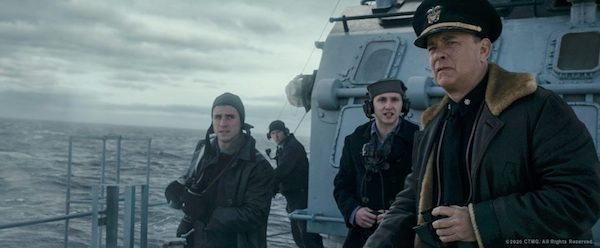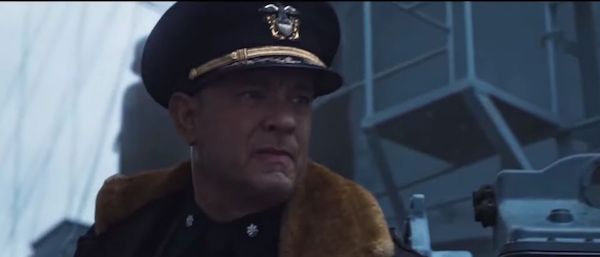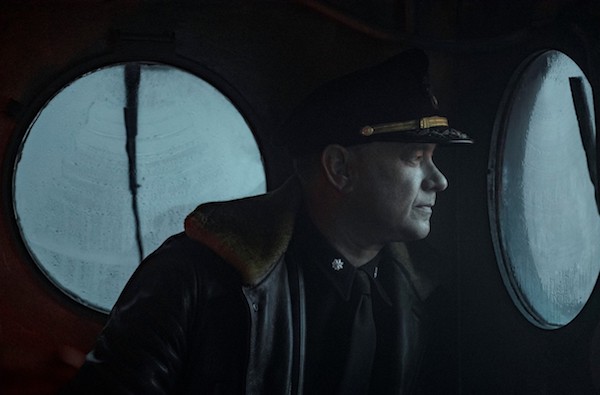A World War II thriller set in the North Atlantic, Greyhound sits right in the middle of the war genre, complete with diverse crew, demonized villains, and escalating battles. It’s been slammed by some “top critics” as “old-fashioned,” “perfunctory,” and the like, although you could just as easily say “professional” and “well-made.”

Greyhound has an ambitious structure that incorporates flashbacks, stream-of-consciousness montages, elided action, and several sustained sequences that expertly combine several narrative threads. It boasts an impressive visual palette that unfortunately would have been much more effective in a movie theater.
It also features Tom Hanks as Ernie Krause, the greenhorn captain of the Greyhound, one of three destroyers accompanying a 37-ship convoy of troops and war matériel across the North Atlantic. It’s similar to his Captain John H. Miller in Saving Private Ryan, a soldier smarter than his rank but also dangerously inexperienced. When we first see him, washing his face in his cabin, it’s a bit of a shock. Bleary-eyed, nervous, he’s decades away from physically fit. And he manages to make clear his lack of confidence, his desperation.
Hanks is an actor of enormous curiosity, and his choices about how to play Krause are consistently rewarding. The movie makes a bit of a fuss about his faith, a red flag to some critics but also the basis of many of the decisions Krause makes. Early on he must decide whether to be merciful or just to two soldiers who had been fighting. Later he is faced with an awful dilemma: stop to rescue survivors of an attack, or hurry forward to defend the rest of the convoy. Krause’s faith helps him find solutions.
Those are choices based on the script and the director, Aaron Schneider. Hanks has other tactics to flesh out his character. Watch how difficult it is for him to read a funeral service: he speeds through passages by rote, saying the words without the delivery of a practiced public speaker. He stumbles and stutters, makes mistakes, is anything but a swaggering, confident Hollywood captain. There are moments of panic in his eyes, other times when he hurtles through situations without thinking, relying on meager training and instinct.

Hanks wrote the screenplay, adapting the C.S. Forester novel The Good Shepherd. He condenses several incidents and scenes but largely stays true to Forester’s premise: the convoy is relatively safe from German U-boats as long as it has air cover. But there is a fifty-hour stretch in the middle of the ocean when they are out of range of air support, when they are most vulnerable to attack.
In novels like The African Queen and his books featuring Horatio Hornblower, Forester excelled not only in marine writing, in explaining what it’s like to be on the water, but in his vivid, highly visual plotting. Written in 1955, The Good Shepherd was largely an interior monologue of Ernie’s thoughts during the fifty hours he is the sole protector of the convoy. Hanks visualizes many of Forester’s ideas without dwelling on them. Krause has problems with his feet, for example, and there is a reason he won’t eat the many meals prepared for him.
What’s especially difficult, however, is visualizing Krause’s strategy. He has to anticipate the moves of the “wolfpack” of U-boats surrounding the convoy. Should he go left, right, or aim dead center at whatever location the radar suggests? What will the U-boat captain do? In the novel Forester has the luxury of working out all the moves in Krause’s mind. Hanks is forced to verbalize them without explaining the strategy behind them. The result: a lot of barked orders to “Left standard rudder” or “half-speed” and the like.

Unlike war movies set on land, naval battles seem to occur in slow motion. Choose “left rudder” and the result won’t be apparent for several minutes. There’s no immediate gratification in Greyhound, no crushing the enemy’s throat after hand-to-hand combat, no running through a hail of bullets to blow up the machine gun nest. You might not even see a successful hit on a U-boat.
Greyhound works up its tension the hard way, through intricately structured combat scenes. Long shots of heaving seas and distant ships alternate with tight shots of Krause running back and forth across the bridge, looking for some way to increase his odds.
The movie occasionally breaks from the novel’s point-of-view, notably when the camera soars high above the convoy so viewers can appreciate the ships as chess pieces. But it is tightly, intently focused on Krause and the immediate crew members on his bridge. We share their terror over the fifty undefended hours, get some sense of what they were facing.
And we get Tom Hanks delivering another exceptional performance, the kind viewers may be taking for granted. Like the movie itself, it’s a role that would work even better on screen.


